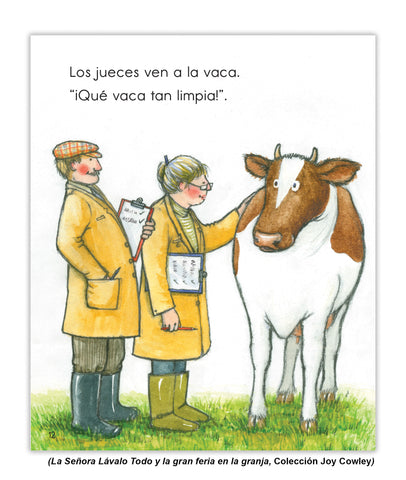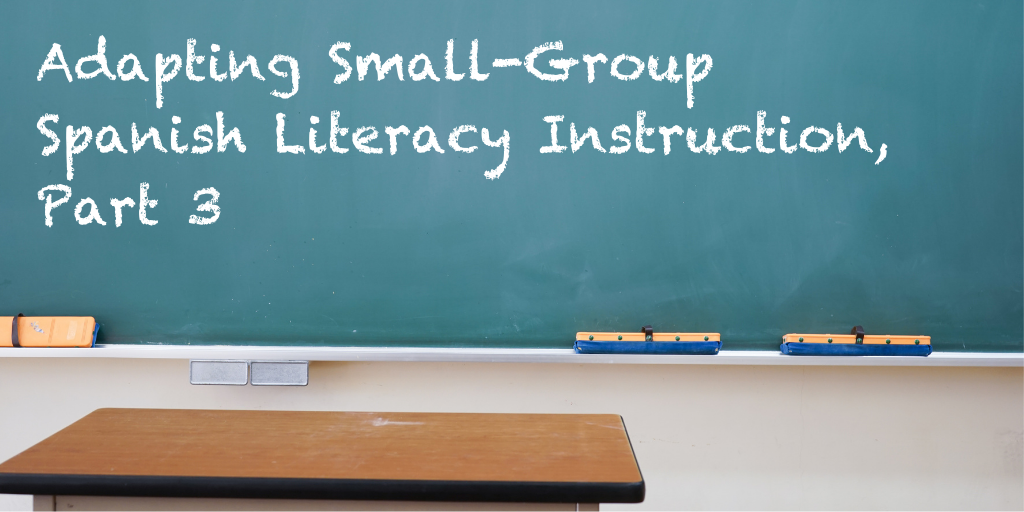This three-part blog series was previously published; we are re-sharing it to support teachers as they plan for guided reading groups, especially in a dual language setting.
Part 1: Book Selection –Find a "just right" book for your reading group
Part 2: Book Introduction –Prepare students before reading
Part 3: First Read –Support students with effective prompts and cues
By Carla Bauer-Gonzalez
Now that we have discussed book selection and introduction, it's time for students to have a successful first reading! Learn about prompts and cues to use as students read a book for the first time.
Reading the Book
Once again, I turn to Marie Clay for guidance, as she states:
" Prepared by the teacher's introduction, the child should attempt to read the new material as independently as possible. "
She continues and shares that the overall aim for students is to:
- Read a new text with fluency and understanding
- Problem-solve difficulties by searching the print, the picture, the language, and the story
- Seek help from the teacher, who then prompts searching and confirms good responses
- Independently and with ease, read a new text, solve and decode any unknown words, and maintain fluency
After the book orientation, we begin "lectura susurrada." During "whisper reading," each child reads their book at their own pace. I spend the first few minutes listening and helping as needed, then meet individually with each student for a few minutes.
The following are excerpts from Las Pumas' first reading of La se ñora Lávalo Todo y la gran feria en la granja.
 Leo: Los jueces van a la vaca...ven...Qué vaca más limpia...tan Maestra (Teacher): Vuelve a leerlo Leo. Leo: (Hace los mismo errores) Maestra (Teacher): Algo no se ve been. Haz que se vea todo bien. Leo rereads the passage and corrects the second error, but not the first. I let this error go because it makes sense and looks similar to the text word.
Leo: Los jueces van a la vaca...ven...Qué vaca más limpia...tan Maestra (Teacher): Vuelve a leerlo Leo. Leo: (Hace los mismo errores) Maestra (Teacher): Algo no se ve been. Haz que se vea todo bien. Leo rereads the passage and corrects the second error, but not the first. I let this error go because it makes sense and looks similar to the text word.
Gross Visual Discrepancies and the Scale of Help: While Leo's second error does not impact meaning, it does represent a "gross visual discrepancy" (GVD) in which not even the first letter is observed. Starting at around Levels 5-6, children should have consistent control over visual analysis using the first letter and monitoring these errors. When Leo didn't catch the mistake, I gave him a little more information, " Something still doesn't look right. Re-read it. " Had this not worked, I would have asked him to re-read a third time, helping him see the ' t ' and the beginning of ' tan .' Had this still failed, I would have told him " dice tan " and asked him to re-read. Clay calls this gradual adding of support in prompting a "scale of help" (Clay, 2016, p. 153), which promotes independent solving and monitoring.
 Maestra (Teacher): Aquí están los jueces.
Maestra (Teacher): Aquí están los jueces.
Lilly: Los jueces ven el cerdo y el pato...al...al. Qué cerdo tan ni-ni-t-ni...
Maestra (Teacher): Nítido. Como "neat" en ingles. He looks neat and clean. Nítido.
Maestra (Teacher): Vuelve a leer y pon ‘nítido’ en el cuento.
Lilly: (vuelve a leer correctamente y acaba la página.)
Maestra (Teacher): Cuándo nos juntemos, puedes explicar a Leo y Aaron como te ayudó pensar en ingles “neat and clean” para solucionar “nitido” en español?
Page-Turn Plants: I knew that ' jueces ' would not be a word in Lilly's lexicon, so I replanted it before Lilly started reading. Because this replanting happens just after the page has been turned, I call it a "page-turn plant."
Letting It Go: If the error doesn't impact meaning and looks pretty close to the text word, consider letting it go, especially if the text word or structure is not yet part of her oral language. When Lilly substituted ' el ' for ' al ' in " Los jueces ven el cerdo ," I did not address it because the contraction ' al ' for ' el ' is not part of her fundamental knowledge. Save teaching points for more critical and generative items.
Tagged TOLDS: When Lilly struggled with the word ' nítido,' I gave her a TOLD and then "tagged" it with some helpful information. Because nítido is probably not a word she will ever say or have to read again, I don't want her to burn up mental energy solving it. But I want her to realize that words she knows in English (cognates) can help her solve Spanish words, hence the tag.
Re-reading to Reintegrate: Re-reading after problem-solving is so essential. It helps to reintegrate the decoding work we just did back into a bigger story and restarts forward momentum.
Sharing the Learning: Using words we already know in English to solve new Spanish words is a lesson worth sharing! I will call upon her to tell Leo and Aaron about nítido and neat during our collective conversation after reading.
 Aaron: Bien...Bien...I don't know the word 'hecho,' but they got their prizes. Maestra (Teacher): Sus premios. Y la Sra. esta super feliz y dice...(apunta debaio de 'bien'). Aaron: Bien... Maestra (Teacher): Enseñate la primera parte. Aaron: Bien... Maestra (Teacher): Bien he...
Aaron: Bien...Bien...I don't know the word 'hecho,' but they got their prizes. Maestra (Teacher): Sus premios. Y la Sra. esta super feliz y dice...(apunta debaio de 'bien'). Aaron: Bien... Maestra (Teacher): Enseñate la primera parte. Aaron: Bien... Maestra (Teacher): Bien he...
Aaron: Bien hecho.
Maestra (Teacher): ¿Tienes razon? Revisalo para decidir.
Aaron: (se enseña las partes hecho y dice hecho. )
Maestra (Teacher): Es hecho ?
Aaron: Si.
Maestra (Teacher): ¿Miraste el dibujo para alistar tu cerebro antes de leer?
Aaron: Sí. (No lo hizo.)
Maestra (Teacher): ¿Qué está pasando aquí en el dibujo?
Aaron: (Considera el dibujo.)
Maestra (Teacher): Vuelve a leer.
Aaron: (Vuelve a leer correctamente y acaba la página sin errores.)
Maestra (Teacher): Cuando nos juntemos, debes explicar a Lilly y Leo cómo te ayudó pensar en el cuento y decir la primera parte en hecho.
Getting Ready to Read: Aaron is often hyperfocused on syllable reading and forgets to think about the story. For other students, who are more anchored in the meaning of the text, I might have skipped looking at the illustration again and gone directly to "show yourself the first part." But for Aaron, the missing piece is thinking before reading. Helping him re-engage this part of his processing almost always helps him.
Decide tú. (You decide): To foster Aaron's independence, he must learn how to check for himself whether he's right. When he said ' hecho' after the prompting transaction, I called on him to make sure ' hecho ' made sense and looked right.
The End of the Lesson
The reading is finished, and it's nearly time to go. We sit down together to talk about the story.
Maestra (Teacher): Bueno. ¿Qué piensan?
Leo: Me gustó.
Lilly: Me too.
Maestra (Teacher): ¿Sí? ¿Por qué?
Lilly: They all got premios.
Maestra (Teacher): Todos ganaron premios.
Leo: No TODOS. La Señora no. Solo los animales.
Maestra (Teacher): Aaron…¿Qué piensas? ¿Crees que la Señora debería ganar un premio?
Aaron: No. She's not an animal.
Lilly: But ella hace todo la trabajo.
Maestra (Teacher): Sí. Hizo todo el trabajo.
Lilly: And los animales were chillando when ella está lavando.
A grammatically correct Spanish conversation? No.
Reading Success? YES!
All three of Las Pumas understood the story and seemed to enjoy it. Each brought their unique repertoire of oral language, decoding knowledge, and processing skills. Each student shared something they had learned about being a capable Spanish reader!
I hope this blog series has given you some ideas and strategies to address diverse levels of language proficiency in your classroom!
~~~
Spanish-leveled reading books will help you lead your dual-language and bilingual classrooms on a path to literacy. These guided reading books are Spanish adaptations of our best-selling English titles, translated by a team of fluent literacy educators. Big book versions are perfect for shared reading and read-alouds. Guided reading levels A–M.
~~~







